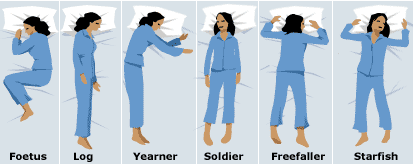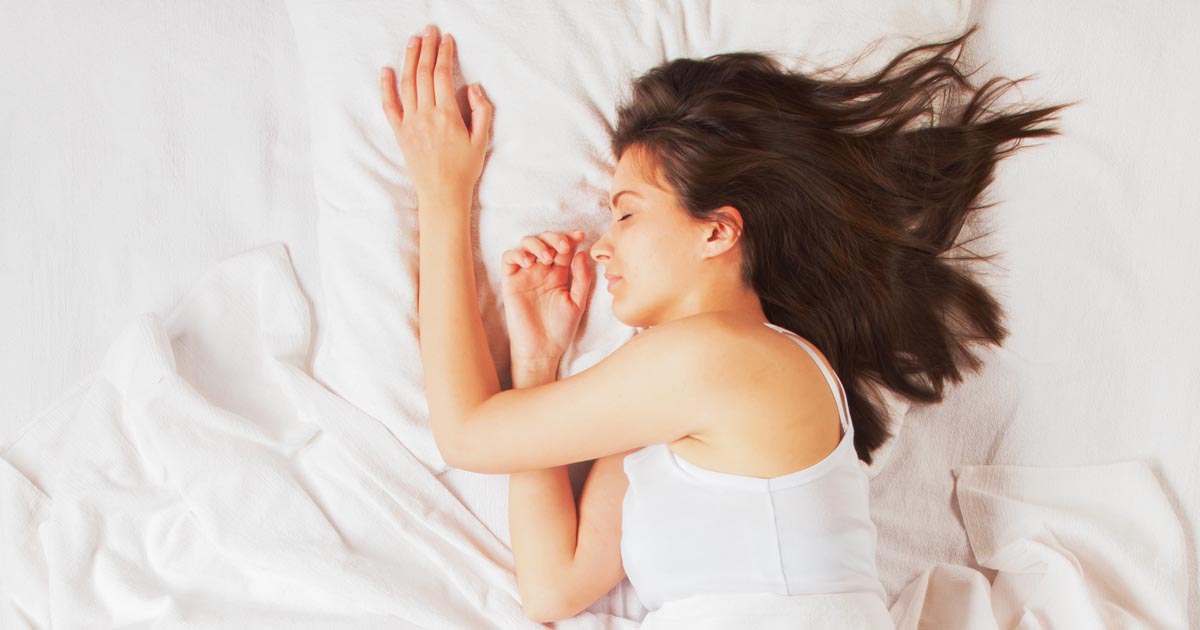Although your personal sleep position might seem like a quirky detail to include on a “fun facts about you” questionnaire, the way that you fall asleep can say a lot about you, including your chances of developing back pain and other health problems. Here are the eight main sleeping positions, what they say about you, and how to improve the quality of your sleep.

Position 1: Sleeping on your Stomach
People who sleep facing downwards, with the side of their head resting either on a pillow or directly onto their mattress, report feeling protected by their sleeping position, since the entire front of their body faces downwards. However, sleeping on your stomach could be the worst sleeping position for your spine. Stomach sleeping doesn’t offer any support for your back, and it also forces your head to the side, which can cause neck pain. If possible, try other sleeping positions–your spine will thank you.
Position 2: Back, Arms Down
If you sleep on your back with your arms down, you probably take your health seriously. Research has shown that this sleeping position is the best one for your spine health, because it allows your mattress to keep your back in a neutral position. However, back sleeping isn’t recommended for anyone who suffers from sleep apnea or who snores, because the pressure from your chest and neck tissues can restrict your breathing. If you sleep on your back, try to vary your sleep positions throughout the night, and talk with your spouse, roommate, or family members about whether you snore. If they report that you snore loudly, talk with your doctor about being screened for sleep apnea.
Position 3: Back, Arms Above Your Head
Sleeping on your back with your arms up is referred to as the “starfish position,” and it can do more than keep your spine healthy and comfortable. Back sleeping with your arms above your head has been found to ward off facial wrinkles and breakouts. If you have a tendency to sleep on your back, consider investing in an adjustable base for your mattress, which can allow you to raise or lower the head or foot portions of your bed. With an adjustable mattress, back sleepers can enjoy a mattress that accommodates the natural contours of the body.
Position 4: Side, Curled Up
Experts say that people who sleep on their sides with their bodies curled up might portray a tough exterior, while actually being soft and friendly. However, this position, also referred to as the “fetal position,” is one of the worst positions for your overall health. In addition to restricting your breathing, the fetal position can also put pressure on your back and neck. If you sleep on your side, place a pillow between your knees to keep your spine in a neutral position and to encourage your body to unfurl slightly as you sleep.
Position 5: Side, Straight With Arms Down
Sleeping in a straight up-and-down position with your arms at your side has been shown to have a variety of health perks, including limiting back pain and reducing instances of sleep apnea. Side sleeping might also be a good sign for your personality. According to a research study that focused on personality tied to sleep positions, people who slept on their side with their arms down tended to be easygoing and trusting of other people.
Position 6: Side, Arms Out In Front
Sleeping on your side with your arms out in front might make you look like you are ready for anything, but it could actually contribute to those “dead arms” in the morning. Sleeping on your side naturally restricts blood flow to the arm pinned underneath your body, which can actually become worse if the limb is at a 90-degree angle in front of you. If you have a tendency to sleep on your side with your arms in front, consider sleeping with smaller covers to encourage yourself to stay huddled under those warm blankets.
Position 7: Right Side
If you sleep on your right side, be warned: you might be doing a number on your internal organs. Right-side sleeping has been found to put pressure on your internal organs, including your stomach, liver, and lungs. Sleeping on your right side can also aggravate heartburn, which can affect the quality of your sleep. If you tend to sleep on your right side, consider switching sides of the bed, which can help some people to naturally gravitate to sleeping on their left side.
Position 8: With A Pillow
People who sleep with a pillow often use it as a barrier. In addition to making it easier to maintain their own space in bed, people who sleep with a pillow enjoy a variety of musculoskeletal benefits, since the pillow can be used to reduce pressure points. Pillows can be placed under the knees for back sleepers to keep the spine in a neutral position, or underneath the head to keep the neck comfortable.
For more information about improving the quality of your sleep, contact a Las Vegas mattress store near you. Friendly sales associates can show you different mattress models to meet your personal sleep habits, so that you can get the best rest of your life.





























No Comments
Leave a comment Cancel